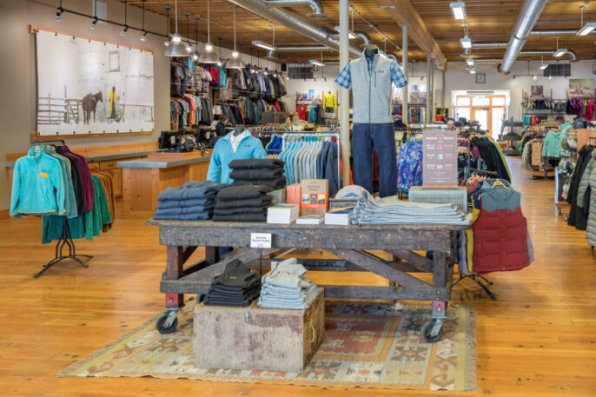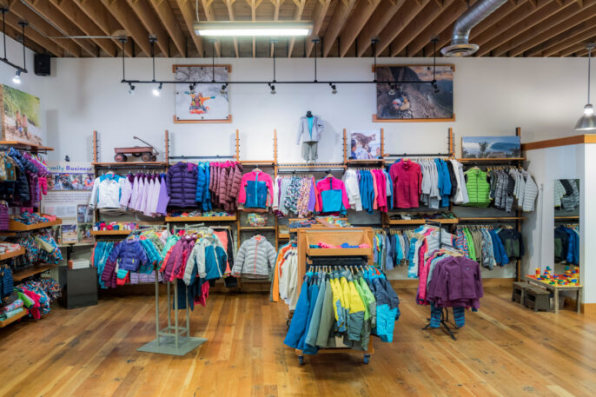If your mental picture of Montana includes snow-capped mountain peaks, a small town with a river running through it, or vast stretches of ranch land, you’ll find them all in Dillon, a small ranching community about 115 miles southwest of Bozeman. What may surprise here is a sprawling Patagonia store, one of only six outlets for the clothing company. The location is perhaps more fitting than meets the eye: Yvon Chouinard started Patagonia by making pitons for rock climbing from an old harvester blade.
Motorists driving north or south along I-15, which connects San Diego to Canada, may not realize that they’re passing by the likes of a 12,000-head cattle ranch owned by Rupert Murdoch and farms that harvest seed potatoes and wheat, among other crops. Flanked by the Pioneer and Tobacco Root mountain ranges, the valley has a storied history—like much of the West—that includes a stop by the explorers Lewis and Clark and an 1860s-era gold rush. The more modern story of how a Patagonia store ended up here is almost as legendary, and it all began after Chouinard spent a day fly fishing with friends.
The Patagonia founder has long had a fondness for Dillon, and he makes summertime trips to fish the Blue Ribbon trout streams in the area. By the late 1980s, Chouinard also had a reason to visit for business because Patagonia began contracting out some work to a local sewing company owned by a friend and fellow angler.

Over some beers after a day of fishing, that same friend made a bold suggestion: Why not open a store in Dillon? While she wasn’t there to witness this exchange, Beth Sullivan has told the story many times in her long-running tenure as the general manager of the Dillon outlet, which opened in November 1990—only a matter of weeks after Chouinard took the bait. “I always say they were yucking it up over some beverages,” she tells Fast Company with a laugh.
Turns out, the idea wasn’t a farce. Chouinard knew an outlet was the right choice for this unlikely location because he wanted to sell lower-priced items to people who would really use them, be it for recreation, ranching, or braving the elements. Thanks to the partnership with the sewing company, Patagonia had a location to make the store a reality very quickly. And, as luck had it, a veteran of the company’s outlet business was already planning a move to the state.
That veteran was Sullivan, who began working for Patagonia in the mid-1980s at its original outlet, Real Cheap Sports in Ventura, California, before swapping coasts to help open an outlet in Freeport, Maine. She was weeks from moving to Bozeman to work in what was then the company’s phone and catalog center when she got an offer to instead open the Dillon outlet.
While Sullivan jumped at the opportunity, others in the company were skeptical. “In the beginning, people were a little side-eyed when Yvon was like, ‘Yeah, we’re going to open a store,’” Sullivan recalls, adding that she, too, was surprised by just how small Dillon was on her first visit. Its population has hovered around 4,000 since the 1990s, and places like Butte, Missoula, Bozeman, Billings, and Idaho Falls are all at least an hour’s drive away, if not more.
‘The Patagonia Pilgrimage’
The Dillon outlet eventually became a destination, inspiring what some Westerners refer to as “the Patagonia pilgrimage,” and big sale weeks once brought in crowds of 10,000-plus, though foot traffic has continued to suffer post-pandemic, Sullivan says.
Outlets serve an important role for a company that’s committed to sustainability and has an intentionally small footprint. Patagonia currently has 35 flagship stores in the United States, with a 36th location set to open later this year in Charlotte, North Carolina. The Dillon outlet receives items that didn’t sell in the prior season at six flagship stores, which means that while temperatures are currently hovering in the 20s or 30s, shoppers will find the store stocked with shorts and other warm-weather fare.
The store is also an institution of sorts because it awards grants to local organizations, hosts events in Dillon and beyond, and donates clothing and gear. Employees, several of whom have worked there for decades, complete “activism” hours in the community.

But the Dillon location is also unique for the company itself. When the store moved down the block in the 2010s, Patagonia bought the building that now houses the outlet—an old grocery store—one of only a few store locations it owns. And later this year, it will become a flagship for Patagonia’s workwear line, Sullivan adds.
Some Montanans are still bemused that Dillon, of all places, has a Patagonia outlet, but the store’s success says a lot about how Chouinard ran the company for nearly 50 years before he gave up his ownership stake to fight climate change in 2022. “He always has great ideas,” Sullivan says. “In the end, they seem to work.”
Login to add comment
Other posts in this group


On Sunday OpenAI cofounder and CEO Sam Altman published a blog post titled Reflections about his company’s progress—and the speed bumps along t


Elon Musk has never been shy about sharing his opinions to his 211 million followers on X. But for those who follow him—and those who get his posts pushed into

The man who drove a truck into a crowd of people in

China has slammed a decision by the

NASA’s upcoming Artemis II mission is slated to return astronauts to the Moon no sooner than April 2026. Astronauts were last on the
